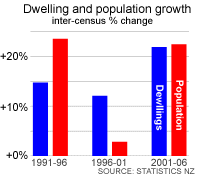 By Rodney Dickens
By Rodney Dickens
As the official website of Whitainga says, it offers: Swimming, diving, bushwalking, scenic cruises, soaking in a hot pool at low tide, horse riding, fishing, kayaking, relaxed shopping, dining on local cuisine, golfing, bonecarving - experience the magic and relax in our unspoilt playground of paradise - a recreational haven just waiting for you.
In addition the Whitianga Waterways offers sections with berths and a subdivision adjacent to the airport, which parallels the offering at Pauanui. Whitianga's popularity for both holiday homes and to permanent residents has grown strongly since at least 1991. Whitianga's permanent population has grown much stronger than the national population and the number of occupied dwellings “ as distinct from unoccupied dwellings/holiday homes “ have also grown much stronger in Whitianga. Unoccupied dwellings in Whitianga, which largely reflects holiday homes, have grown strongly since 1996. 
This chart shows growth in Whitianga's usually resident or permanent population and in the total number of dwellings over five-year periods. Part of Whitianga's attraction is to retirees, with 18.5% of locals aged 65 years and over in the 2006 Census compared with 12.3% nationally, 12.4% in Waikato and 17.4% in Tauranga City.
After strong growth between 2001 and 2006, which largely coincided with the coastal property boom, we expect Whitianga to have slower growth over the next few years, something like what happened between 1996 and 2001 after the strong growth between 1991 and 1996 (see chart above). What appeared to happen between 1991 and 1996 was that population growth ran well above growth in the total number of dwellings, which will have been partly accommodated by new permanent residents buying former holiday homes.
However, holiday home owners appear to have reclaimed their territory between 1996 and 2001 resulting in the total number of dwellings growing much stronger than the permanent population. But between 2001 and 2006 there was strong growth in both holiday home owners and permanent residents. The high level of new subdivision activity and house building between 2001 and 2006 will have created more jobs, helping fuel growth in the number of permanent residents.
However, with new subdivision activity slowing and residential building activity having fallen dramatically growth in permanent residents is likely to slow and some people in the building related trades could leave town in search of work. Like many coastal resorts, Whitianga's property market is suffering from indigestion while affordability is a major challenge for many would-be holiday home owners even though property prices are falling (see the November 2008 overview report on the coastal property market for insights in to affordability and other issues). So we expect the uptake of sections to be significantly lower over the next several years than was experienced between 2001 and 2006.
Quantifying Whitianga's section and housing indigestion challenges
In searching the REINZ website www.realestate.co.nz we found 158 ads for sections for sale in Whitianga but this reduced to 113 sections when we removed multi-listings and a few ads for places up the coast. When we add the sections for private sale listed on www.trademe.co.nz and the sections for sale by developers we identified 225 sections for sale, including a few larger lifestyle sections on the periphery of town.
On our visit we found 14 sections advertised for private sale, seventy advertised for sale through real estate agents in the subdivisions we visited (i.e. likely to largely reflect investors trying to excite the market), 104 sections for sale by developers on the primary market, 239 empty sections not for sale but available to be built on, 15 spec houses for sale, 17 houses under construction and one section advertised by a builder as a house and land package.
Based on the information sourced from www.realestate.co.nz, www.trademe.co.nz and from the brochures of local developers, these charts show the asking prices and sizes of the sections advertised for sale. The first chart shows the number of sections advertised for sale by price bracket, while the second chart shows the breakdown of sections for sale by size bracket. Not all sections advertised for sale specified size and/or asking price. The price breakdown shows the two main tiers of the local market, with the upper-priced tiermainly associated with the Whitianga Waterways development for a significant number of additional sections are plan as well as other development, with only the sections already developed being included in the charts below.
On www.realestate.co.nz we found 457 ads for dwellings for sale which will include some amount of double counting, with a local real estate agent estimating that there were 350 dwellings listed for sale. This means around 12% of the housing stock is advertised for sale which is well above levels of around 8% we have found in other coastal areas (see the reports on our website).
There is little doubt that Whitianga currently faces a major indigestion problem with both sections and dwellings, meaning that local prices are likely to significantly under-perform the national market for some time to come. A real estate agent suggested that dwelling prices had already fallen around 20% on average while he indicated that sections that had been asking around $220,000 were now asking around $170,000 - at least that was the case with would-be vendors who were more serious about selling. But even then the number of section sales was said to be very low in part because buying existing dwellings was seen as being more attractive than buying sections and building, which was partly because local building costs were said to be well above average.
To put the current supply of sections in Whitianga in perspective, between 2001 and 2006 the total number of dwellings in Whitianga increased by 492, an average of 98.4 per annum. If we make the rather optimistic assumption that building activity will run at this rate over the next several years it means that, based on the 225 sections we found advertised for sale and the 239 sections we found not for sale but not yet built on, there are enough sections currently available to satisfy a bit over 4.5 years of demand for new building. However, as discussed briefly above we expect demand for sections from both holiday home owners and permanent residents to be significantly lower over the next several years than over the last 5-10 years.
Our ballpark guess is that over the next few years new house building in Whitianga could be as low as half the average rate between 2001 and 2006 (i.e. around 50 per annum), which implies there are currently enough vacant sections to satisfy as much as nine years of demand for sections to build on. As covered in our pay-to-view Housing Prospects reports we are in the early stages of a reasonably significant upturn in housing demand that will reduce the downward pressure on property prices over the rest of this year and could even be strong enough to result in price increases in the New Year. But it will take an avalanche of new demand to quickly correct the adverse demand-supply balance faced by would-be vendors in Whitianga so for some time to come we expect downside pressure on local prices, especially in the case of sections where the demand-supply balance is most adverse for would-be vendors.
The AA Travel website travel calculator says Whitianga is 187 km or 2 hr 20 min from Auckland, 181 km or 2 hr 15 min from Hamilton, 189 km or 2 hr 20 min from Tauranga, 659 km or 8 hr 15 min from Wellington and 1,087 km or 16 hr 15 min from Christchurch.
* Rodney Dickens is the Managing Director and Chief Research Officer for Strategic Risk Analysis (SRA), which is a boutique economic, industry and property research company. Rodney produces regular free reports on topical issues and on specific property markets.
Find out more about SRA here and sign up to SRA's free reports here.

We welcome your comments below. If you are not already registered, please register to comment
Remember we welcome robust, respectful and insightful debate. We don't welcome abusive or defamatory comments and will de-register those repeatedly making such comments. Our current comment policy is here.